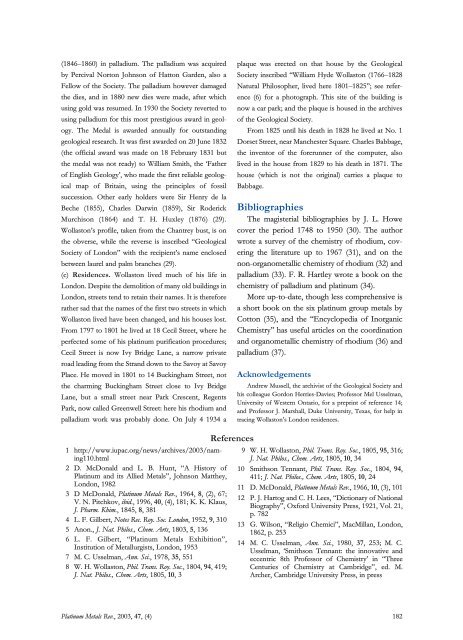Bicentenary of Four Platinum Group Metals - Platinum Metals Review
Bicentenary of Four Platinum Group Metals - Platinum Metals Review
Bicentenary of Four Platinum Group Metals - Platinum Metals Review
You also want an ePaper? Increase the reach of your titles
YUMPU automatically turns print PDFs into web optimized ePapers that Google loves.
(1846–1860) in palladium. The palladium was acquired<br />
by Percival Norton Johnson <strong>of</strong> Hatton Garden, also a<br />
Fellow <strong>of</strong> the Society. The palladium however damaged<br />
the dies, and in 1880 new dies were made, after which<br />
using gold was resumed. In 1930 the Society reverted to<br />
using palladium for this most prestigious award in geology.<br />
The Medal is awarded annually for outstanding<br />
geological research. It was first awarded on 20 June 1832<br />
(the <strong>of</strong>ficial award was made on 18 February 1831 but<br />
the medal was not ready) to William Smith, the ‘Father<br />
<strong>of</strong> English Geology’, who made the first reliable geological<br />
map <strong>of</strong> Britain, using the principles <strong>of</strong> fossil<br />
succession. Other early holders were Sir Henry de la<br />
Beche (1855), Charles Darwin (1859), Sir Roderick<br />
Murchison (1864) and T. H. Huxley (1876) (29).<br />
Wollaston’s pr<strong>of</strong>ile, taken from the Chantrey bust, is on<br />
the obverse, while the reverse is inscribed “Geological<br />
Society <strong>of</strong> London” with the recipient’s name enclosed<br />
between laurel and palm branches (29).<br />
(c) Residences. Wollaston lived much <strong>of</strong> his life in<br />
London. Despite the demolition <strong>of</strong> many old buildings in<br />
London, streets tend to retain their names. It is therefore<br />
rather sad that the names <strong>of</strong> the first two streets in which<br />
Wollaston lived have been changed, and his houses lost.<br />
From 1797 to 1801 he lived at 18 Cecil Street, where he<br />
perfected some <strong>of</strong> his platinum purification procedures;<br />
Cecil Street is now Ivy Bridge Lane, a narrow private<br />
road leading from the Strand down to the Savoy at Savoy<br />
Place. He moved in 1801 to 14 Buckingham Street, not<br />
the charming Buckingham Street close to Ivy Bridge<br />
Lane, but a small street near Park Crescent, Regents<br />
Park, now called Greenwell Street: here his rhodium and<br />
palladium work was probably done. On July 4 1934 a<br />
plaque was erected on that house by the Geological<br />
Society inscribed ‘‘William Hyde Wollaston (1766–1828<br />
Natural Philosopher, lived here 1801–1825’’; see reference<br />
(6) for a photograph. This site <strong>of</strong> the building is<br />
now a car park; and the plaque is housed in the archives<br />
<strong>of</strong> the Geological Society.<br />
From 1825 until his death in 1828 he lived at No. 1<br />
Dorset Street, near Manchester Square. Charles Babbage,<br />
the inventor <strong>of</strong> the forerunner <strong>of</strong> the computer, also<br />
lived in the house from 1829 to his death in 1871. The<br />
house (which is not the original) carries a plaque to<br />
Babbage.<br />
Bibliographies<br />
The magisterial bibliographies by J. L. Howe<br />
cover the period 1748 to 1950 (30). The author<br />
wrote a survey <strong>of</strong> the chemistry <strong>of</strong> rhodium, covering<br />
the literature up to 1967 (31), and on the<br />
non-organometallic chemistry <strong>of</strong> rhodium (32) and<br />
palladium (33). F. R. Hartley wrote a book on the<br />
chemistry <strong>of</strong> palladium and platinum (34).<br />
More up-to-date, though less comprehensive is<br />
a short book on the six platinum group metals by<br />
Cotton (35), and the ‘‘Encyclopedia <strong>of</strong> Inorganic<br />
Chemistry’’ has useful articles on the coordination<br />
and organometallic chemistry <strong>of</strong> rhodium (36) and<br />
palladium (37).<br />
Acknowledgements<br />
Andrew Mussell, the archivist <strong>of</strong> the Geological Society and<br />
his colleague Gordon Herries-Davies; Pr<strong>of</strong>essor Mel Usselman,<br />
University <strong>of</strong> Western Ontario, for a preprint <strong>of</strong> reference 14;<br />
and Pr<strong>of</strong>essor J. Marshall, Duke University, Texas, for help in<br />
tracing Wollaston’s London residences.<br />
1 http://www.iupac.org/news/archives/2003/naming110.html<br />
2 D. McDonald and L. B. Hunt, “A History <strong>of</strong><br />
<strong>Platinum</strong> and its Allied <strong>Metals</strong>”, Johnson Matthey,<br />
London, 1982<br />
3 D McDonald, <strong>Platinum</strong> <strong>Metals</strong> Rev., 1964, 8, (2), 67;<br />
V. N. Pitchkov, ibid., 1996, 40, (4), 181; K. K. Klaus,<br />
J. Pharm. Khim., 1845, 8, 381<br />
4 L. F. Gilbert, Notes Rec. Roy. Soc. London, 1952, 9, 310<br />
5 Anon., J. Nat. Philos., Chem. Arts, 1803, 5, 136<br />
6 L. F. Gilbert, “<strong>Platinum</strong> <strong>Metals</strong> Exhibition”,<br />
Institution <strong>of</strong> Metallurgists, London, 1953<br />
7 M. C. Usselman, Ann. Sci., 1978, 35, 551<br />
8 W. H. Wollaston, Phil. Trans. Roy. Soc., 1804, 94, 419;<br />
J. Nat. Philos., Chem. Arts, 1805, 10, 3<br />
References<br />
9 W. H. Wollaston, Phil. Trans. Roy. Soc., 1805, 95, 316;<br />
J. Nat. Philos., Chem. Arts, 1805, 10, 34<br />
10 Smithson Tennant, Phil. Trans. Roy. Soc., 1804, 94,<br />
411; J. Nat. Philos., Chem. Arts, 1805, 10, 24<br />
11 D. McDonald, <strong>Platinum</strong> <strong>Metals</strong> Rev., 1966, 10, (3), 101<br />
12 P. J. Hartog and C. H. Lees, “Dictionary <strong>of</strong> National<br />
Biography”, Oxford University Press, 1921, Vol. 21,<br />
p. 782<br />
13 G. Wilson, “Religio Chemici”, MacMillan, London,<br />
1862, p. 253<br />
14 M. C. Usselman, Ann. Sci., 1980, 37, 253; M. C.<br />
Usselman, ‘Smithson Tennant: the innovative and<br />
eccentric 8th Pr<strong>of</strong>essor <strong>of</strong> Chemistry’ in “Three<br />
Centuries <strong>of</strong> Chemistry at Cambridge”, ed. M.<br />
Archer, Cambridge University Press, in press<br />
<strong>Platinum</strong> <strong>Metals</strong> Rev., 2003, 47, (4) 182
















